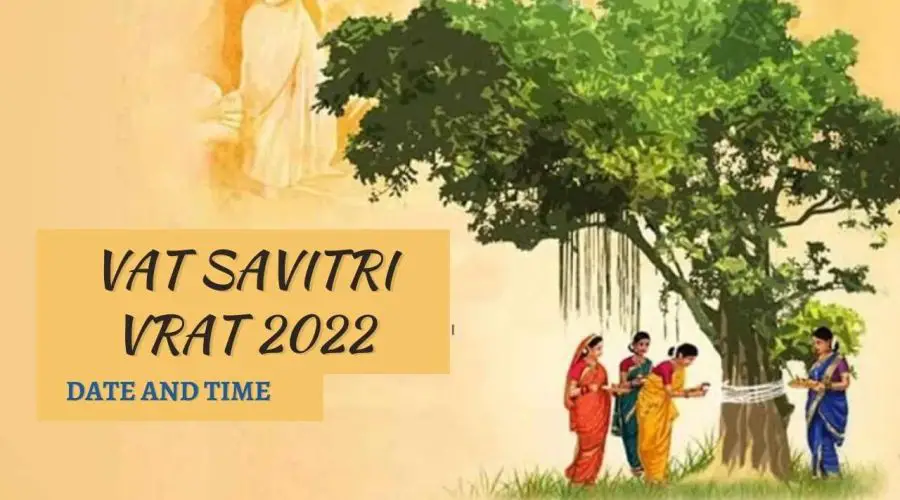Vat Savitri Vrat (Bargad Pooja) 2022: Date, Time, Rituals and Significance
One of the most important fasts observed by married Hindu women in India is the Vat Savitri Vrat. On this day, women fast and pray for their husband’s long life and good health. Vat Savitri Vrat is observed on Amavasya in some Indian states, while Purnima is observed in others, both in the month of Jyeshta.
Vat Savitri Vrat is held in the month of Jyeshtha on Amavasya tithi — also known as Jyeshtha Amavasya — according to the Amanta calendar 2022.
The fast falls on the day of Jyeshtha Amavasya, according to the Purnimanta calendar 2022 observed in North Indian states such as Bihar, Punjab, Uttar Pradesh, Haryana, and Madhya Pradesh.
Vat Savitri Vrat 2022 Date
Vata Savitri Amavasya on Monday, May 30, 2022
Vat Savitri Purnima Vrat on Tuesday, June 14, 2022
Amavasya Tithi Begins – 02:54 PM on May 29, 2022
Amavasya Tithi Ends – 04:59 PM on May 30, 2022
Married Indian women observe Vat Savitri Vrat for the health and longevity of their husbands and children. According to Hindu legend, on this day, Devi Savitri convinced Lord Yamaraja, the God of Death, to bring her husband, Satyawan, back to life. Lord Yamaraja was so moved by her devotion that He returned her spouse to her. Married ladies have been offering prayers to the ‘Vat’ (Bargad) tree since then, and Savitri is also revered as ‘Devi Savitri’ on this day.
Importance of Vat Savitri Vrat
- According to Hindu mythology, the Vat (Banyan) tree represents the ‘Trimurtis,’ which represent Lord Vishnu, Lord Brahma, and Lord Shiva. The banyan tree is said to bring good fortune to those who worship it.
- Many scriptures and Puranas, such as the Skanda Purana, Bhavishyottara Purana, Mahabharata, and others, stress the importance of fasting.
- Hindu married women fast and perform Vat Savitri puja for their husbands’ prosperity, good health, and longevity.
Observing Vat Savitri Vrat is regarded as a sign of a married woman’s dedication and sincere love for her husband.
Vat Savitri Vrat Rituals
- Before sunrise, women take a holy bath with Amla (Indian gooseberry) and til (sesame seeds) and change into new clothes. They apply vermillion and bangles — accouterments associated with married women — and swear a nirjala (no water) fast.
- Devotees ingest the roots of the Vat (Banyan) tree with water if the fast lasts three days.
- They tie a red or yellow colored sacred thread around the trunk of the Vat tree after giving prayers to it.
- Women adorn the banyan tree with rice, flowers, and water, and perform Parikrama (circumambulation) around it while chanting prayers.
- If a banyan tree is not available, devotees can make an image of it using sandalwood paste of turmeric on a wooden base and complete the rites in the same way.
- On the day of Vat Savitri, devotees must also prepare unique dishes and sacred cuisine. After the puja, prasad is distributed to all members of the household.
- In their households, women also seek the blessings of the elderly.
- Devotees should help the poor by donating clothing, food, money, and other necessities.
Frequently Asked Questions
1. Who can do Vat Savitri Vrat?
On the Amavasya Tithi of the Jyeshtha month, married Hindu women from North India observe the Vat Savitri Vrat. Shani Jayanti, a day dedicated to Shani Dev, the incarnation of Saturn, coincides with the festivities (Shani).
2. Can we drink water in Vat Savitri Vrat?
After morning activities, women apply amala (Indian gooseberry) and gingli (sesamum) paste and bathe on Trayodashi day. Women then consume water and eat the roots of the Vata Vriksha (Banyan Tree). In fact, many ladies only consume this for three days.
3. How can I break Vat Savitri fast?
They keep a tight fast all night and break it the next day once the Purnima is finished. They bring the Banyan tree water, rice, and flowers, sprinkle vermillion, knot the tree’s trunk with cotton threads, and circumambulate it 108 times.
4. What do you eat on Savitri?
Wet pulses, rice, mangos, jackfruits, palm fruits, kendu, bananas, and a variety of other fruits are offered as Bhoga (offering) and Savitri brata katha is observed during the festival. Fasting is over after a full day of fasting, and the women are given Bhoga.

